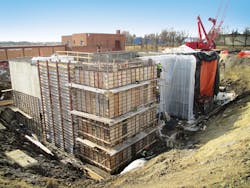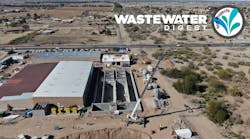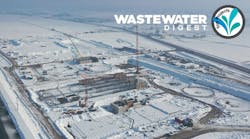Cost: $10.25 million
Location: Dickinson, N.D.
Year: 2016-12-12
Size: 18 mgd
Owner: North Dakota State Water Commission
Designers: Bartlett & West, AECOM JV
Contractor: John T. Jones Construction Co., Muth Electric Inc., Central Mechanical Inc.
In the late 1980s, the Southwest Pipeline Project (SWPP) came to fruition and began supplying raw and treated water to cities and rural communities across southwestern North Dakota. The project developed raw water intake from the Missouri River, as well as a series of reservoirs, pump stations and pipelines more than 85 miles long. Now, almost 30 years later, the towns served by the project—including Dickinson, N.D.—have larger populations and greater water needs, but an aging water treatment plant (WTP).
These factors combined to create the perfect storm. According to Jim Lennington, project manager for engineering firm Bartlett & West, the pumping functions at the plant began to affect the operations and maintenance of the treatment functions, and vice versa. A necessary expansion was on the horizon. Enter the Dickinson Finished Water Pump Station (FWPS).
A key component of the multiphase expansion of the SWPP, the FWPS separated the pumping functions from the WTP, thus removing what was becoming a “major problem with the aging WTP facility,” Lennington said. “[The separation] provided needed flexibility for both entities.”
Built adjacent to the aging infrastructure, the new FWPS includes a 0.5-million-gal concrete clear well 30 ft underground. It provides treated water by way of three 250-hp vertical turbine pumps to the main Dickinson Pressure Zone PZ1 (totaling 6,200 gal per minute [gpm]) and to Dickinson Pressure Zone PZ2N (5,300 gpm). It also provides treated water by way of three 40-hp vertical turbine pumps to the SWPP system (5,600 gpm). Finally, it provides for three future pumps for Dickinson Pressure Zone PZ2S (1,060 gpm).
The pumps were designed to utilize variable-speed electric motors to match the varying heads, flow rates and pressures in the separate systems. Now, all operational data, pumping systems, and flow metering are monitored and controlled remotely utilizing a SCADA system that interfaces with the SWPP system.
A 30-ft-deep piping and valving vault—separate from the original 6-million-gal concrete storage reservoir—was incorporated into the station design. This vault allows for the sequenced transfer and multi-phased startup of the station; operation with or without the adjacent reservoir; switchover to the future WTP; and operation of the system without the clear well.
As part of the new additions, separate 30-in.-diameter inlets and outlets were installed on the concrete storage reservoir. Bored-and-jacked casings were designed to go below the 30-ft-deep tank footing and into the reservoir bottom. Because the soil was moderately corrosive, special sealing material and reinforcing techniques were applied to the new penetrations, including cathodic protection for the ductile iron pipe.
Now, nearly a year since its completion, Lennington said that the FWPS is “operational. That pretty much sums it up and is the best description of a successful project.”
But the SWPP expansion is not over yet. “A new, 12-million-gal-per-day Bartlett & West/AECOM JV-designed surface water treatment plant that utilizes membrane treatment and lime softening is now under construction adjacent to the pump station and is scheduled for completion in 2017,” said Mark Reitz, project manager for AECOM Technical Services Inc. “All of these facilities will provide the city of Dickinson and other cities and rural areas of southwest North Dakota with a more reliable, state-of-the-art, reduced maintenance, and cost-effective potable water treatment and delivery system for the next 50 years.”
Project Year: 2016-12-12Contractor: John T. Jones Construction Co., Muth Electric Inc., Central Mechanical Inc.Designers: Bartlett & West, AECOM JVOwner: North Dakota State Water CommissionLocation: Dickinson, N.D.Cost: $10.25 millionSize: 18 mgd

